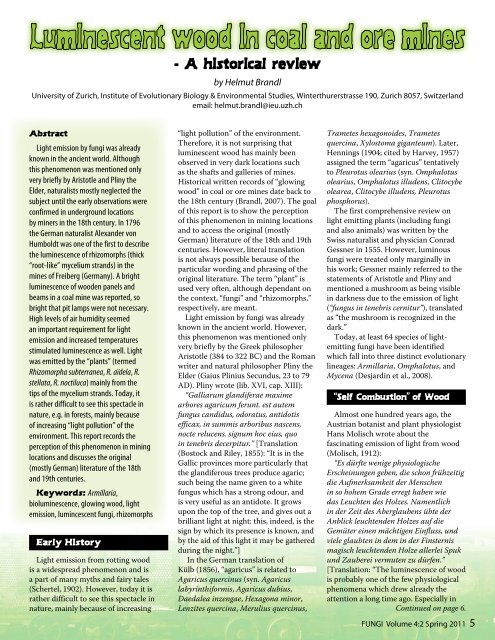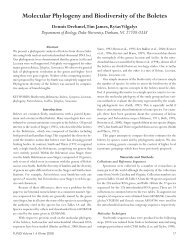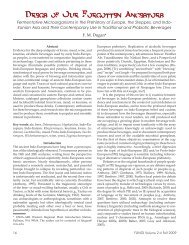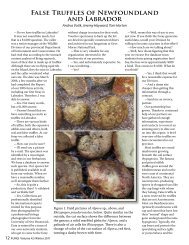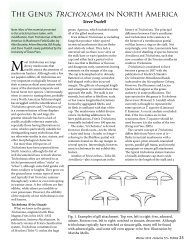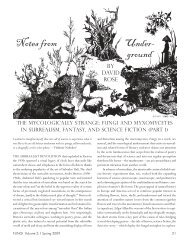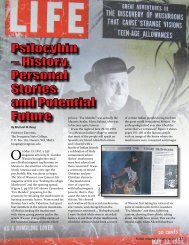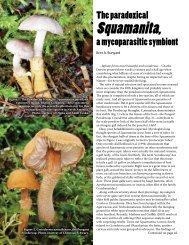by Helmut Brandl
by Helmut Brandl
by Helmut Brandl
You also want an ePaper? Increase the reach of your titles
YUMPU automatically turns print PDFs into web optimized ePapers that Google loves.
y <strong>Helmut</strong> <strong>Brandl</strong><br />
University of Zurich, Institute of Evolutionary Biology & Environmental Studies, Winterthurerstrasse 190, Zurich 8057, Switzerland<br />
email: helmut.brandl@ieu.uzh.ch<br />
Abstract<br />
Light emission <strong>by</strong> fungi was already<br />
known in the ancient world. Although<br />
this phenomenon was mentioned only<br />
very briefly <strong>by</strong> Aristotle and Pliny the<br />
Elder, naturalists mostly neglected the<br />
subject until the early observations were<br />
confirmed in underground locations<br />
<strong>by</strong> miners in the 18th century. In 1796<br />
the German naturalist Alexander von<br />
Humboldt was one of the first to describe<br />
the luminescence of rhizomorphs (thick<br />
“root-like” mycelium strands) in the<br />
mines of Freiberg (Germany). A bright<br />
luminescence of wooden panels and<br />
beams in a coal mine was reported, so<br />
bright that pit lamps were not necessary.<br />
High levels of air humidity seemed<br />
an important requirement for light<br />
emission and increased temperatures<br />
stimulated luminescence as well. Light<br />
was emitted <strong>by</strong> the “plants” (termed<br />
Rhizomorpha subterranea, R. aïdela, R.<br />
stellata, R. noctiluca) mainly from the<br />
tips of the mycelium strands. Today, it<br />
is rather difficult to see this spectacle in<br />
nature, e.g. in forests, mainly because<br />
of increasing “light pollution” of the<br />
environment. This report records the<br />
perception of this phenomenon in mining<br />
locations and discusses the original<br />
(mostly German) literature of the 18th<br />
and 19th centuries.<br />
Keywords: Armillaria,<br />
bioluminescence, glowing wood, light<br />
emission, lumincescent fungi, rhizomorphs<br />
Light emission from rotting wood<br />
is a widespread phenomenon and is<br />
a part of many myths and fairy tales<br />
(Schertel, 1902). However, today it is<br />
rather difficult to see this spectacle in<br />
nature, mainly because of increasing<br />
“light pollution” of the environment.<br />
Therefore, it is not surprising that<br />
luminescent wood has mainly been<br />
observed in very dark locations such<br />
as the shafts and galleries of mines.<br />
Historical written records of “glowing<br />
wood” in coal or ore mines date back to<br />
the 18th century (<strong>Brandl</strong>, 2007). The goal<br />
of this report is to show the perception<br />
of this phenomenon in mining locations<br />
and to access the original (mostly<br />
German) literature of the 18th and 19th<br />
centuries. However, literal translation<br />
is not always possible because of the<br />
particular wording and phrasing of the<br />
original literature. The term “plant” is<br />
used very often, although dependant on<br />
the context, “fungi” and “rhizomorphs,”<br />
respectively, are meant.<br />
Light emission <strong>by</strong> fungi was already<br />
known in the ancient world. However,<br />
this phenomenon was mentioned only<br />
very briefly <strong>by</strong> the Greek philosopher<br />
Aristotle (384 to 322 BC) and the Roman<br />
writer and natural philosopher Pliny the<br />
Elder (Gaius Plinius Secundus, 23 to 79<br />
AD). Pliny wrote (lib. XVI, cap. XIII):<br />
“Galliarum glandiferae maxime<br />
arbores agaricum ferunt. est autem<br />
fungus candidus, odoratus, antidotis<br />
efficax, in summis arboribus nascens,<br />
nocte relucens. signum hoc eius, quo<br />
in tenebris decerpitur.” [Translation<br />
(Bostock and Riley, 1855): “It is in the<br />
Gallic provinces more particularly that<br />
the glandiferous trees produce agaric;<br />
such being the name given to a white<br />
fungus which has a strong odour, and<br />
is very useful as an antidote. It grows<br />
upon the top of the tree, and gives out a<br />
brilliant light at night: this, indeed, is the<br />
sign <strong>by</strong> which its presence is known, and<br />
<strong>by</strong> the aid of this light it may be gathered<br />
during the night.”]<br />
In the German translation of<br />
Külb (1856), “agaricus” is related to<br />
Agaricus quercinus (syn. Agaricus<br />
la<strong>by</strong>rinthiformis, Agaricus dubius,<br />
Daedalea inzengae, Hexagona minor,<br />
Lenzites quercina, Merulius quercinus,<br />
Trametes hexagonoides, Trametes<br />
quercina, Xylostoma giganteum). Later,<br />
Hennings (1904; cited <strong>by</strong> Harvey, 1957)<br />
assigned the term “agaricus” tentatively<br />
to Pleurotus olearius (syn. Omphalotus<br />
olearius, Omphalotus illudens, Clitocybe<br />
olearea, Clitocybe illudens, Pleurotus<br />
phosphorus).<br />
The first comprehensive review on<br />
light emitting plants (including fungi<br />
and also animals) was written <strong>by</strong> the<br />
Swiss naturalist and physician Conrad<br />
Gessner in 1555. However, luminous<br />
fungi were treated only marginally in<br />
his work; Gessner mainly referred to the<br />
statements of Aristotle and Pliny and<br />
mentioned a mushroom as being visible<br />
in darkness due to the emission of light<br />
(“fungus in tenebris cernitur”), translated<br />
as “the mushroom is recognized in the<br />
dark.”<br />
Today, at least 64 species of lightemitting<br />
fungi have been identified<br />
which fall into three distinct evolutionary<br />
lineages: Armillaria, Omphalotus, and<br />
Mycena (Desjardin et al., 2008).<br />
Almost one hundred years ago, the<br />
Austrian botanist and plant physiologist<br />
Hans Molisch wrote about the<br />
fascinating emission of light from wood<br />
(Molisch, 1912):<br />
“Es dürfte wenige physiologische<br />
Erscheinungen geben, die schon frühzeitig<br />
die Aufmerksamkeit der Menschen<br />
in so hohem Grade erregt haben wie<br />
das Leuchten des Holzes. Namentlich<br />
in der Zeit des Aberglaubens übte der<br />
Anblick leuchtenden Holzes auf die<br />
Gemüter einen mächtigen Einfluss, und<br />
viele glaubten in dem in der Finsternis<br />
magisch leuchtenden Holze allerlei Spuk<br />
und Zauberei vermuten zu dürfen.”<br />
[Translation: “The luminescence of wood<br />
is probably one of the few physiological<br />
phenomena which drew already the<br />
attention a long time ago. Especially in<br />
Continued on page 6.<br />
FUNGI Volume 4:2 Spring 2011<br />
5
times of superstition, luminescent wood<br />
had a great influence on the mind, and<br />
many suspected spook and magic when<br />
confronted with it in the dark.”]<br />
Figure 1 shows a piece of wood which<br />
emits light. The light is easily visible in<br />
a very dark room after adaptation of<br />
the eyes to the darkness for about five<br />
Figure 1. Luminescent wood,<br />
photographed in daylight (top)<br />
and in the dark (bottom) with an<br />
exposure time of 15 sec.<br />
minutes.<br />
Originally, the reason for the<br />
light emission was attributed to the<br />
rotting of wood based on oxidation<br />
processes (Heinrich, 1815). A kind of<br />
“self-combustion” was assumed or a<br />
decomposition of water concomitant<br />
to a slow combustion of hydrogen<br />
released (“ein Vegetiren im Feuchten,<br />
ein Zersetzen des Wassers, ein damit<br />
gleichzeitiges, sanftes Verbrennen des<br />
frey werdenden Wasserstoffgases in<br />
der unterirdischen Atmosphäre zu<br />
erkennen” from Nees von Esenbeck,<br />
6 FUNGI Volume 4:2 Spring 2011<br />
1823). [Translation: “A rotting under<br />
damp conditions, a decomposition of<br />
water, a gentle combustion of hydrogen<br />
gas released in the subterrestrial<br />
atmosphere.”]<br />
The cause, however, was in the<br />
infection of the wood <strong>by</strong> fungi, mainly<br />
Armillaria mellea (honey mushroom)<br />
(Molisch, 1912). Rhizomorphs of<br />
A. mellea (thick tubular “root-like”<br />
morphological structures) emit greenishwhite<br />
light whereas the fruit body is<br />
non-luminescent: “Das Licht wird<br />
überall gleich beschrieben als ruhig und<br />
gleichförmig anhaltend, bläulichgrün bis<br />
schön grün” (Heller, 1853) or “The light<br />
is everywhere described as quiet and<br />
uniform, bluish-green to green.”<br />
Both Conrad Gessner and Francis<br />
Bacon (philosopher and statesman)<br />
recognized that the light emission from<br />
wood was not related to heat radiation.<br />
Bacon wrote (Bacon, 1620):<br />
“Omne ignitum ita ut vertatur in<br />
ruborem igneum etiam sine flamma<br />
perpetuo calidum est;[…] sed quod<br />
in proximo est videtur esse lignum<br />
putre, quod splendet noctu neque<br />
tamen deprehenditur calidum, […].”<br />
[Translation: “All things which are lit will<br />
end up in fiery redness and are always<br />
hot even without flames, (…) but what<br />
comes nearest seems to be rotten wood,<br />
which shines <strong>by</strong> night and yet is not<br />
found to be hot, (…).”]<br />
Today it is known that the light<br />
originates from a metabolic reaction<br />
of the fungus where electrons are<br />
transferred to an acceptor (luciferin)<br />
which is cleaved <strong>by</strong> an enzyme<br />
(luciferase) in the presence of oxygen.<br />
This results in the formation of an<br />
electronically excited state of the<br />
luciferin and the subsequent emission<br />
of light with a maximum wavelength of<br />
approximately 525 nm during return to<br />
the ground state (Airth and McElroy,<br />
1959; Hastings, 1996). An example<br />
of a mushroom (Mycena illuminans)<br />
exhibiting light emission from stems and<br />
fruit bodies is shown in Figure 2.<br />
In a funny story, Friedrich Ludwig<br />
reported how luminous wood was picked<br />
up from the ground to lighten the route<br />
when returning home close to midnight<br />
from a trip trough the dark forest<br />
(Ludwig, 1901):<br />
“An der Strasse, die von Greiz nach<br />
dem idyllisch gelegenen Ida-Waldhaus<br />
führt, waren an einem Waldschlag,<br />
der von hallimaschkranken Fichten<br />
bestanden war, Wurzelstöcke ausgerodet<br />
und in Klaftern aufgeschichtet worden.<br />
Da das von dem Hallimaschpilz befallene<br />
Holz regelmässig leuchtet, bieten<br />
derartige Schlage in finsterer Nacht einen<br />
prächtigen Anblick und die Passanten<br />
ziehen öfter mit den leuchtenden<br />
Holzstücken vom Waldhaus nach Greiz<br />
heimwärts, was dem Beschauer wie ein<br />
gespenstischer Laternenzug erscheint.”<br />
[Translation: “On the road leading from<br />
Greiz (town in Thuringia, Germany) to<br />
idyllic Ida-Waldhaus, wood and roots<br />
from Armillaria-infected pine trees<br />
have been stacked. Because the wood<br />
emits light continuously, these stacks<br />
present a gorgeous sight in the dark and<br />
pedestrians often walk home with the<br />
luminescent wood, giving the impression<br />
of a spooky parade.”]<br />
The Austrian physician and chemist<br />
Johann Florian Heller addressed the early<br />
descriptions <strong>by</strong> Aristotle and Pliny and<br />
related them to the occurrence of fungi<br />
in mining locations (Heller, 1853):<br />
“Eines der interessantesten<br />
altliterarischen Daten, welches ich<br />
bisher auffinden konnte und unter<br />
den alten Autoren von wirklichem<br />
Werthe erscheint, ist die Mittheilung<br />
von Aristoteles (de anima Lit. II. Cap.<br />
VII.), dass nämlich manche Schwämme<br />
im Finstern einen leuchtenden<br />
Schein verbreiten sollen. Spätere<br />
Naturforscher läugneten es, bis man<br />
wieder bei Grubenbauten durch die<br />
Bergleute die schon von Aristoteles<br />
gemachte Beobachtung bestättigt fand.“<br />
[Translation: One of the most interesting<br />
facts in the ancient literature is the<br />
remark of Aristotle (de anima Lit. II. Cap.<br />
VII.) that many sponges emit light in the<br />
dark. Later however, naturalists denied
Figure 2. Tropical mushroom Poromycena manipularis growing on wood<br />
(Danum Valley Field Center, Borneo, Malaysia). Photo taken with flash (top)<br />
and without illumination (bottom; exposure time of 30 sec).<br />
this phenomenon until the observation<br />
made <strong>by</strong> Aristotle was confirmed in<br />
underground mines <strong>by</strong> miners.”]<br />
According to Alexander von<br />
Humboldt it was Johann Carl Freiesleben<br />
(at this time assessor of the board of<br />
mines) who in 1796 was the first to<br />
observe luminescence of rhizomorphs in<br />
the mines of Freiberg (Germany). Von<br />
Humboldt (1799) stated:<br />
“Erst seit kurzem halte ich mich durch<br />
glaubwürdige Zeugen versichert, dass in<br />
den Gruben selbst phosphorescierendes<br />
Holz gesehen worden ist. Alte Bergleute in<br />
der Marienberger-Bergamtsrevier haben<br />
diese seltne Erscheinung beobachtet, und<br />
ein allgemein geschätzter, vortreflicher<br />
Beobachter, Herr Freiesleben hat mir<br />
im Sommer 1796 Fragmente einer<br />
unterirdischen Pflanzen geschickt,<br />
welche er selbst leuchtend gefunden und<br />
frisch für mich gesammelt hatte. Diese<br />
Pflanze war ein Lichen filamentosus<br />
und meinem L. pinnatus nahe<br />
verwandt. An der Wirklichkeit dieses<br />
Phänomens ist demnach keineswegs<br />
zu zweifeln.“ [Translation: “Reliable<br />
witnesses confirmed the presence of<br />
phosphorescing wood in the mines. Old<br />
miners of the Marienberg mine observed<br />
this rare event and I was given fragments<br />
of an underground plant freshly<br />
sampled <strong>by</strong> Mr. Freiesleben. There is<br />
no doubt about the occurrence of this<br />
phenomenon.”]<br />
Von Humboldt noticed that<br />
the temperature optimum of the<br />
luminescence was between 8 and 15°C<br />
whereas at temperatures of >32°C light<br />
emission was not observable any more.<br />
However, he was not able to isolate<br />
light-emitting compounds from wood<br />
(Harvey, 1957). It was the director of<br />
the board of mines (von Derschau)<br />
who noticed that light was exclusively<br />
emitted from black lines and streaks<br />
on the wood which could be scrapped<br />
off <strong>by</strong> hand. In a letter, he reported the<br />
bright luminescence of wooden supports<br />
and wooden beams in a coal mine; so<br />
bright that pit lamps were not necessary<br />
(Harvey, 1957). Von Derschau’s letter<br />
was published <strong>by</strong> the German botanist<br />
Theodor Friedrich Ludwig Nees von<br />
Esenbeck (Nees von Esenbeck, 1823):<br />
“Der Steiger bemerkte mir, dass<br />
man in dieser Strecke an einzelnen<br />
Stellen keiner Lampe bedürfe, indem<br />
das Holzwerk hinreichend leuchte. [...]<br />
Bei näherer Betrachtung fand ich das<br />
Holzwerk mit blaulich leuchtenden<br />
Linien und Puncten überzogen, welche<br />
die einzelnen Thürstöcke und Kappen<br />
bezeichneten, und an einigen Stellen<br />
so hell schimmerten, dass man bei<br />
diesem Schein die Fläche meiner<br />
Hand wahrnehmen konnte. Meine<br />
Begleiter wollten dies dem faulenden<br />
Holz zuschreiben, so oft ich aber nach<br />
jenen leuchtenden Puncten griff gerieten<br />
immer Teile der Pflanze […] in meine<br />
Hand. Eine noch nähere Untersuchung<br />
bewiess mir, dass nur diese Pflanze […]<br />
Continued on page 8.<br />
FUNGI Volume 4:2 Spring 2011<br />
7
das Leuchten hervorbringe, und zwar<br />
besonders die End- und Triebspitzen<br />
derselben, welche letztere gewöhnlich<br />
weiss sind und zuweilen herunterhängen.<br />
Beim Zerreiben einer solchen Spitze<br />
in der Grube leuchteten die Finger<br />
einige Secunden lang.” [Approximate<br />
translation: “I was told <strong>by</strong> the foreman<br />
that in certain locations no pit lamps are<br />
necessary because the wood was emitting<br />
enough light. A close observation<br />
showed the presence of bluish lines and<br />
spots on the wood, so bright at some<br />
locations that my hand was visible. My<br />
companions attributed the phenomenon<br />
to rotten wood, but whenever I tried to<br />
touch the spots I always caught parts<br />
of these plants [termed Rhizomorpha<br />
subterranea <strong>by</strong> von Derschau]. A closer<br />
investigation showed that light was<br />
emitted especially from the tips of the<br />
shoots. After grinding the tips, my<br />
fingers glowed for a few seconds.”]<br />
The German geologist Johann Jacob<br />
Nöggerath added to Nees von Esenbeck’s<br />
publication the following remarks:<br />
“Die Gewohnheit, Bergwerke nur mit<br />
Geleuchte zu befahren, ist vielleicht<br />
allein Ursache, dass diese auffallende<br />
Erscheinung nicht früher beobachtet<br />
wurde.” [Translation: “The practice to<br />
work in the mines only with pit lamps is<br />
perhaps the reason that this remarkable<br />
occurrence was not observed earlier.”]<br />
Several years later in a letter to<br />
Nöggerath, Freiesleben reported<br />
observations made <strong>by</strong> assessor Erdmann<br />
in the coal mines of Grossburgk [village<br />
close to Dresden, Germany]. Erdmann<br />
reported the light emission from wooden<br />
supports, so intense that people located<br />
in front of the supports were clearly<br />
recognizable (Freiesleben, 1825):<br />
“Die leuchtende Pflanze habe ich hier<br />
(in Burgk) in wundersamer Schönheit<br />
gefunden; ich werde den Anblick ihrer<br />
Herrlichkeit nie vergessen. Wie in ein<br />
Zauberschloss tritt man in das Ort,<br />
wo sie sich in solcher Menge befindet,<br />
dass sie Seitenstösse, Firste und<br />
Thürstöcke ganz übersponnen hat, und<br />
in ihrem strahlenden Phosphorglanze<br />
fast das Auge blendet. Der Schein,<br />
den sie verbreitet, ist wie blasses<br />
Mondenlicht, so dass zwei Personen, nahe<br />
zusammenstehend, die Umrisse ihrer<br />
Körper erkennen können.” [Translation:<br />
“I have found the luminescent plant in<br />
wondrous beauty. I will never forget its<br />
magnificence. The location looks like<br />
8 FUNGI Volume 4:2 Spring 2011<br />
a magic castle. Plants are present in<br />
such amounts that wooden frames and<br />
supports are completely covered. The<br />
eyes are almost blinded <strong>by</strong> the bright<br />
phosphorescence. The shine is like faint<br />
moonlight and the persons standing<br />
close to each other can recognize their<br />
silhouettes.”]<br />
Years later, Heller addressed again<br />
von Derschau’s letter and expanded the<br />
report with own observations.<br />
Figure 3. Drawing of wood<br />
overgrown with a fungal mycelium<br />
(from Heller, 1853). Figure 3.<br />
Drawing of wood overgrown with<br />
a fungal mycelium (from Heller,<br />
1853).<br />
Original figure legend: (1) Leuchtender<br />
Pilz auf Holz (Pinus silvestris). [...]<br />
(2) Ebenfalls leuchtender Pilz aus<br />
dem Innern eines leuchtenden<br />
Stück verwesten Holzes (Salix) mit<br />
unbewaffnetem Auge zu sehen. (3)<br />
Leuchtender Pilz (Rhizomorpha<br />
noctiluca) auf verwestem Holz<br />
von Pinus silvestris bei 300maliger<br />
Diametralvergrösserung. […]<br />
[translation: “(1) Luminescent fungus<br />
on wood (Pinus silvestris). […] (2) Again<br />
a luminescent fungus from the interior<br />
of a piece of rotting wood (Salix), visible<br />
to the naked eye. (3) Luminescent<br />
fungus (Rhizomorpha noctiluca) on<br />
rotting wood of Pinus silvestris at 300x<br />
magification]. Heller, 1853):<br />
“Zwei Arten der Pflanzengattung sind<br />
es vorzüglich, welche man in den Gruben<br />
und am Gehölze überhaupt findet, welche<br />
stark leuchten, nämlich Rhizomorpha<br />
aïdela (v. Humboldt) und Rh. stellata<br />
(v. Nees). Die Pflanzen kommen, wenn<br />
sie sich völlig ausbilden, bis zu einigen<br />
20 Fuss langen Ranken, die sich längs<br />
der feuchten Zimmerung ziehen, vor<br />
[…]. Es ist ein ziemlich hoher Grad von<br />
Feuchtigkeit immer eine wesentliche<br />
Bedingung, dass das Leuchten eintrete.<br />
So ist auch etwas mehr Wärme eine<br />
besondere Beförderung doch keineswegs<br />
Bedingung des Leuchtens. So leuchten<br />
die Rhizomorphen nach meinen und<br />
Anderer Beobachtungen viel schöner<br />
in Gruben, wo die Temperatur höher<br />
ist und selbst über 20° R. reicht. […]<br />
Vorzüglich kommen diese Rhizomorphen<br />
in Kohlengruben vor, ja man findet sie<br />
selbst auf Thonschiefer aufsitzen.”<br />
[Translation: “Two plant species,<br />
which glow strongly, are found in the<br />
mines and on the wooden panels, namely<br />
Rhizomorpha aïdela (v. Humboldt)<br />
und Rh. stellata (v. Nees). Fully grown,<br />
plants can be 20 feet long, growing<br />
along the wooden frames […] A high<br />
degree of humidity is an important<br />
requirement for light emission. Increased<br />
temperatures stimulate luminescence<br />
as well. I observed that rhizomorphs<br />
luminesce more intensely at higher<br />
temperatures even at 20°R. […]<br />
Rhizomorphs occur especially in coal<br />
mines, but can even be found on clay<br />
shale.”]<br />
In Heller’s publication, a drawing of<br />
the fungal mycelium responsible for the<br />
light emission is presented for the very<br />
first time (Fig. 3).<br />
Bioluminescence (light emission <strong>by</strong><br />
animals, plants, fungi, or bacteria) is<br />
widespread in nature and luminescent<br />
leaves and wood are easy to find on a<br />
walk through the forest, even during the<br />
day (Bothe, 1931). Molisch and Dobat<br />
give a simple description (Molisch and<br />
Dobat, 1979):<br />
“Wenn man eine Umfrage halten<br />
würde, wie viele Menschen von<br />
Hundert leuchtendes Holz in der Natur<br />
gesehen haben, so würde sich nur eine<br />
verhältnismässig geringe Zahl dazu
ekennen. Die meisten Menschen gehen<br />
nicht gern im finsteren Wald spazieren,<br />
und so bleibt es gewöhnlich dem Zufall<br />
überlassen, bis endlich jemand auf<br />
leuchtendes Holz stösst. Man hat es<br />
infolgedessen für eine grosse Seltenheit<br />
gehalten, aber zu Unrecht, denn es<br />
gelingt ziemlich leicht, sich solches<br />
Holz zu verschaffen: Löst man von<br />
alten, verwesenden Baumstümpfen z.B.<br />
der Kiefer (Pinus), der Fichte (Picea)<br />
oder der Eiche (Quercus) die Rinde<br />
ab und findet auf dem nackt zutage<br />
Figure 4. Rhizomorphs on the<br />
stump of a pine tree (has exposed<br />
luminescent wood) after removal of<br />
the bark.<br />
liegenden Holz schwarze ‘Adern’ oder<br />
verzweigte schwarze Stränge [see Fig.<br />
4], so ist es sehr wahrscheinlich, dass<br />
man leuchtendes Holz vor sich hat.<br />
Zuerst sammle man die schwarzen<br />
Stränge für sich, lege sie zwischen<br />
feuchtes Papier oder in eine Büchse<br />
und beobachte in der Nacht mit<br />
wohlausgeruhtem Auge. Dann wird<br />
man in vielen Fällen besonders die<br />
jungen, noch weiblichen Spitzen<br />
der schwarzen Stränge im Finstern<br />
leuchten sehen. Die Stränge sind das<br />
Dauermyzel (sog. Rhizomorpha) des<br />
schon genannten Hallimasch, aus dem<br />
die nicht leuchtenden Fruchtkörper<br />
hervorkommen.” [Translation: “Only<br />
a small percentage of people has ever<br />
seen luminescent wood in nature,<br />
because nobody likes to walk through<br />
the forest in the dark. Therefore,<br />
luminescent wood is found only<br />
<strong>by</strong> accident. As consequence, its<br />
occurrence was wrongly taken as rarity,<br />
but this kind of wood is easy to obtain:<br />
Bark has to be removed from old<br />
decaying stumps of e.g. pine, spruce, or<br />
oak. Between the bark and the wood,<br />
black “veins” or branched strands can<br />
be found and it is very likely that one<br />
has exposed luminescent wood. The<br />
black strands can be collected, kept<br />
between wet paper or in a box, and<br />
observed in the night. In many cases,<br />
especially the young tips of the black<br />
strands glow in the dark. These strands<br />
represent the durable mycelium (so<br />
called rhizomorphs) of the honey<br />
mushroom producing the nonluminescent<br />
fruit bodies.”]<br />
The help of Dr. Lindsay Turnbull<br />
in reviewing the manuscript is greatly<br />
acknowledged. Karin Beer and<br />
Philippe Saner provided the pictures<br />
of Poromycena manipularis. Many<br />
thanks go to Dr. Marianne Klug Arter<br />
for supplying a sample of luminescent<br />
wood.<br />
Airth, R.L., and W.D. McElroy.<br />
1959. Light emission from extracts of<br />
luminous fungi. Journal of Bacteriology<br />
77: 249-250.<br />
Bacon, F. 1620. Novum organum.<br />
Liber secundus aphorisorum de<br />
interpretationae naturae sive de regno<br />
hominis. London, 404 pp.<br />
Bostock, J., and H.T. Riley. 1855.<br />
Pliny the Elder: The Natural History.<br />
London: Henry G. Bohn, 555 pp.<br />
Bothe, F. 1931. Über das Leuchten<br />
verwesender Blätter und seine Erreger.<br />
Planta 14: 752-765.<br />
<strong>Brandl</strong>, H. 2007. Die “Lichtfäule”<br />
in Gruben und Bergwerken – ein<br />
historischer Rückblick. Minaria<br />
Helvetica 27b: 41-48.<br />
Desjardin, D.E., A.G. Oliveira,<br />
and C.V. Stevani. 2008. Fungi<br />
bioluminescence revisited.<br />
Photochemistry and Photobiological<br />
Sciences 7: 170-182.<br />
Freiesleben, J.C. 1825.<br />
Lichterscheinungen. I. Leuchten der<br />
Rhizomorphen. Journal der Chemie &<br />
Physik 44: 65-73.<br />
Gessner, C. 1555. Conradi Gesneri<br />
medici de raris et admirandis herbis,<br />
quae sive quod noctu luceant, sive<br />
alias ob causas, lunariae nominantur,<br />
commentariolus & obiter de aliis<br />
etiam rebus quae in tenebris lucent.<br />
Zurich: Apud Andream Gesnerum F. &<br />
Iacobum Gesnerum, 87 pp.<br />
Harvey, E.N. 1957. A History of<br />
Luminescence from the Earliest Times<br />
Until 1900. Philadelphia: The American<br />
Philosophical Society, 692 pp.<br />
Hastings, J.W. 1996. Chemistries and<br />
colors of bioluminescent reactions: a<br />
review. Gene 173: 5-11.<br />
Heinrich, P. 1815. Die Phosphorescenz<br />
der Körper oder die im Dunkeln<br />
bemerkbaren Lichtphänomene der<br />
anorganischen Natur. Nürnberg: Verlag<br />
Johann Leonhard Schrag.<br />
Heller, J.F. 1853. Ueber das Leuchten<br />
im Pflanzen- und Thierreiche. Archiv<br />
für physiologische und pathologische<br />
Chemie und Mikroskopie 6: 44-54,<br />
81-90, 121-137, 161-166, 201-216, and<br />
241-251.<br />
Hennings, P. 1904. Über leuchtende<br />
Hutpilze. Naturwissenschaftliche<br />
Wochenschrift 3: 170-171.<br />
Külb, P.H. 1856. Cajus Plinius<br />
Secundus, Naturgeschichte. Stuttgart,<br />
Metzlersche Buchhandlung. 5 Vol.<br />
Ludwig, F. 1901. Phosphorescierende<br />
Tausendfüssler und die Lichtfäule<br />
des Holzes. Centralblatt für<br />
Bacteriologie, Parasitenkunde und<br />
Infektionskrankheiten (2.Abt.) 7: 270-<br />
274.<br />
Molisch, H. 1912. Leuchtende<br />
Pflanzen. Eine physiologische Studie.<br />
Jena: Gustav Fischer Verlag, 198 pp.<br />
Molisch, H., and K. Dobat.<br />
1979. Botanische Versuche und<br />
Beobachtungen mit einfachen Mitteln.<br />
Stuttgart, Gustav Fischer Verlag, 281<br />
pp.<br />
Nees von Esenbeck, T.F.L. 1823.<br />
Correspondenz. Flora 6: 115-123.<br />
Schertel, S. 1902. Über Leuchtpilze,<br />
unsere gegenwertigen Kenntnisse; ihr<br />
Vorkommen in Litteratur und Mythe.<br />
Deutsche Botanische Monatsschrift<br />
20(3): 39-42, 56-60, 76-77, 139-152.<br />
von Humboldt, F.A. 1799. Ueber<br />
die unterirdischen Gasarten und die<br />
Mittel ihren Nachtheil zu vermindern.<br />
Braunschweig: Verlag Friedrich Vieweg,<br />
384 pp.<br />
FUNGI Volume 4:2 Spring 2011<br />
9


